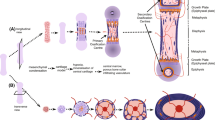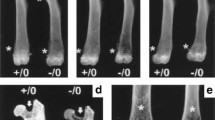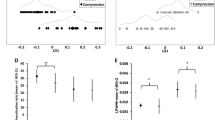Abstract
The heterogeneity of bone shape and size variation is modulated by genetic, mechanical, nutritional, and hormonal patterning throughout its lifetime. Microstructural changes across cross sections are a result of mechanistic optimization that results over the years of evolution while being based on universal, time-invariant ingredients and patterns. Here we report changes across anatomical sections of bone with osteogenesis imperfecta (OI) that undermines the work of evolution through genetic mutation. This work examines the microstructure and molecular composition of different anatomical positions (anterior, medial, posterior, and lateral regions) in the diaphysis of an OI human tibia. The study shows that although there is no significant microstructural difference, molecular changes are observed using FTIR revealing differences in molecular composition of the four anatomical positions. In addition, the nanomechanical properties of anterior section of OI bone seem more heterogeneous. The nanomechanical properties of interstitial lamellae in all these bone samples are consistently greater than those of osteonal lamellae. The nanomechanical properties of bone depend on its anatomical section and on the measurement direction as well. Variations in molecular structure with anatomical positions and also corresponding differences in nanomechanical properties are reported. These are compared to those observed typically in healthy bone illustrating the unique influence of OI on bone multiscale behavior which results from an evolutionary process lasting for many years.







Similar content being viewed by others
References
Abdel-Wahab AA, Alam K, Silberschmidt VV (2011) Analysis of anisotropic viscoelastoplastic properties of cortical bone tissues. Journal of the Mechanical Behavior of Biomedical Materials 4:807–820
Bass SL, Saxon L, Daly RM, Turner CH, Robling AG, Seeman E, Stuckey S (2002) The effect of mechanical loading on the size and shape of bone in pre-, peri-, and postpubertal girls: A study in tennis players. Journal of Bone and Mineral Research 17:2274–2280
Batson EL, Reilly GC, Currey JD, Balderson DS (2000) Postexercise and positional variation in mechanical properties of the radius in young horses. Equine Veterinary Journal 32:95–100
Bertoni E, Bigi A, Cojazzi G, Gandolfi M, Panzavolta S, Roveri N (1998) Nanocrystals of magnesium and fluoride substituted hydroxyapatite. Journal of Inorganic Biochemistry 72:29–35
Biewener AA, Thomason J, Goodship A, Lanyon LE (1983a) Bone Stress in the Horse Forelimb During Locomotion at Different Gaits - A Comparison of 2 Experimental Methods. Journal of Biomechanics 16:565–576
Biewener AA, Thomason J, Lanyon LE (1983b) Mechanics of Locomotion and Jumping in the Forelimb of the Horse (Equus) - Invivo Stress Developed In The Radius And Metacarpus. Journal of Zoology 201:67–82
Burton P, Nyssenbehets C, Dhem A (1989) HAVERSIAN BONE REMODELING IN HUMAN-FETUS. Acta Anatomica 135:171–175
Camacho NP, Hou L, Toledano TR, Ilg WA, Brayton CF, Raggio CL, Root L, Boskey AL (1999) The material basis for reduced mechanical properties in oim mice bones. Journal of Bone and Mineral Research 14:264–272
Camacho NP, Landis WJ, Boskey AL (1996) Mineral changes in a mouse model of osteogenesis imperfecta detected by Fourier transform infrared microscopy. Connective Tissue Research 35:259–265
Cambra-Moo O, Nacarino Meneses C, Rodriguez Barbero MA, Garcia Gil O, Rascon Perez J, Rello-Varona S, Campo Martin M, Gonzalez Martin A (2012) Mapping human long bone compartmentalisation during ontogeny: A new methodological approach. Journal of Structural Biology 178:338–349
Cassella JP, Stamp TCB, Ali SY (1996) A morphological and ultrastructural study of bone in osteogenesis imperfecta. Calcified Tissue International 58:155–165
Cheng ZH, Yasukawa A, Kandori K, Ishikawa T (1998) FTIR study of adsorption of CO2 on nonstoichiometric calcium hydroxyapatite. Langmuir 14:6681–6686
Currey JD (1959) Differences in the Tensile Strength of Bone of Different Histological Types. Journal of Anatomy 93:87–000
Darwin C (1859) On the Origin of Species. John Murray, London, UK
Engelbert RHH, Uiterwaal C, Gulmans VAM, Pruijs H, Helders PJM (2000) Osteogenesis imperfecta in childhood: Prognosis for walking. Journal of Pediatrics 137:397–402
Fan Z, Swadener JG, Rho JY, Roy ME, Pharr GM (2002) Anisotropic properties of human tibial cortical bone as measured by nanoindentation. Journal of Orthopaedic Research 20:806–810
Fan ZF, Smith P, Rauch F, Harris GF (2007a) Nanoindentation as a means for distinguishing clinical type of osteogenesis imperfecta. Composites Part B-Engineering 38:411–415
Fan ZF, Smith PA, Eckstein EC, Harris GF (2006) Mechanical properties of OI type III bone tissue measured by nanoindentation. Journal of Biomedical Materials Research Part A 79A:71–77
Fan ZF, Smith PA, Harris GF, Rauch F, Bajorunaite R (2007b) Comparison of nanoindentation measurements between osteogenesis imperfecta type III and type IV and between different anatomic locations (femur/tibia versus iliac crest). Connective Tissue Research 48:70–75
Fratzl P, Paris O, Klaushofer K, Landis WJ (1996a) Bone mineralization in an osteogenesis imperfecta mouse model studied by small-angle x-ray scattering. Journal of Clinical Investigation 97:396–402
Fratzl P, Schreiber S, Boyde A (1996b) Characterization of bone mineral crystals in horse radius by small-angle X-ray scattering. Calcified Tissue International 58:341–346
Frost HM (1994) Wolff Law and Bones Structural Adaptations to Mechanical Usage - An Overview for Clinician. Angle Orthodontist 64:175–188
Garip S, Severcan F (2010) Determination of simvastatin-induced changes in bone composition and structure by Fourier transform infrared spectroscopy in rat animal model. Journal of Pharmaceutical and Biomedical Analysis 52:580–588
Gosman JH, Hubbell ZR, Shaw CN, Ryan TM (2013) Development of Cortical Bone Geometry in the Human Femoral and Tibial Diaphysis. The Anatomical Record 296:774–787
Gu CJ, Katti DR, Katti KS (2013) Photoacoustic FTIR spectroscopic study of undisturbed human cortical bone. Spectrochimica Acta Part a-Molecular and Biomolecular Spectroscopy 103:25–37
Holguin N, Brodt MD, Sanchez ME, Kotiya AA, Silva MJ (2013) Adaptation of Tibial Structure and Strength to Axial Compression Depends on Loading History in Both C57BL/6 and BALB/c Mice. Calcified Tissue International 93:211–221
Holick MF (2000) Microgravity-induced bone loss - will it limit human space exploration? Lancet 355:1569–1570
Imbert L, Auregan J-C, Pernelle K, Hoc T (2014) Mechanical and Mineral Properties of Osteogenesis Imperfecta Human Bones at the Tissue Level. Bone 65:18–24
Kariem H, Pastrama MI, Roohani-Esfahani SI, Pivonka P, Zreiqat H, Hellmich C (2015) Micro-poro-elasticity of baghdadite-based bone tissue engineering scaffolds: A unifying approach based on ultrasonics, nanoindentation, and homogenization theory. Materials Science & Engineering C-Materials for Biological Applications 46:553–564
Katti KS, Mohanty B, Katti DR (2006) Nanomechanical properties of nacre. Journal of Materials Research 21:1237–1242
Kemp AD, Harding CC, Cabral WA, Marini JC, Wallace JM (2012) Effects of tissue hydration on nanoscale structural morphology and mechanics of individual Type I collagen fibrils in the Brtl mouse model of Osteogenesis Imperfecta. Journal of Structural Biology 180:428–438
Kourkoumelis N, Tzaphlidou M (2010) Multivariate statistical evaluation of bone site and sex as parameters for the Fourier transform infrared spectroscopic study of normal bone. Spectroscopy-an International Journal 24:99–104
Kumar R, Prakash, KH, Cheang P, Gower L, Khor KA (2008) Chitosan-mediated crystallization and assembly of hydroxyapatite nanoparticles into hybrid nanostructured films. Journal of the Royal Society Interface 5:427–439
Malandrino A, Fritsch A, Lahayne O, Kropik K, Redl H, Noailly J, Lacroix D, Hellmich C (2012) Anisotropic tissue elasticity in human lumbar vertebra, by means of a coupled ultrasound-micromechanics approach. Materials Letters 78:154–158
Martins Moreira CL, de Faria Domingues Lima MA, Cabral de Almeida Cardoso MH, dos Santos Gomes Junior SC, Lopes PB, Llerena Junior JC (2011) Independent Walk in Osteogenesis Imperfecta. Acta Ortopedica Brasileira 19:312–315
Mishra S (2009) Biomechanical aspects of bone microstructure in vertebrates: potential approach to palaeontological investigations. Journal of Biosciences 34:799–809
Oliver WC, Pharr GM (1992) An improved technique for determining hardness and elastic-modulus using load and displacement sensing indentation experiments. Journal of Materials Research 7:1564–1583
Pazzaglia UE, Congiu T, Brunelli PC, Magnano L, Benetti A (2013) The Long Bone Deformity of Osteogenesis Imperfecta III: Analysis of Structural Changes Carried Out with Scanning Electron Microscopic Morphometry. Calcified Tissue International 93:453–461
Rauch F, Glorieux FH (2004) Osteogenesis imperfecta. Lancet 363:1377–1385
Rauch F, Travers R, Parfitt AM, Glorieux FH (2000) Static and dynamic bone histomorphometry in children with osteogenesis imperfecta. Bone 26:581–589
Reilly GC, Currey JD (1999) The development of microcracking and failure in bone depends on the loading mode to which it is adapted. Journal of Experimental Biology 202:543–552
Rho JY, Currey JD, Zioupos P, Pharr GM (2001) The anisotropic Young’s modulus of equine secondary osteones and interstitial bone determined by nanoindentation. Journal of Experimental Biology 204:1775–1781
Rho JY, Roy ME, Tsui TY, Pharr GM (1999a) Elastic properties of microstructural components of human bone tissue as measured by nanoindentation. Journal of Biomedical Materials Research 45:48–54
Rho JY, Zioupos P, Currey JD, Pharr GM (1999b) Variations in the individual thick lamellar properties within osteons by nanoindentation. Bone 25:295–300
Riggs CM, Lanyon LE, Boyde A (1993a) Functional Associations Between Collagen Fiber Orientation and Locomotor Strain Direction in Cortical Bone of the Equine Radius. Anatomy and Embryology 187:231–238
Riggs CM, Vaughan LC, Evans GP, Lanyon LE, Boyde A (1993b) Mechanical Implications of Collagen Fiber Orientation in Cortical Bone of the Equine Radius. Anatomy and Embryology 187:239–248
Rubin CT, Lanyon LE (1982) Limb Mechanics as a Function of Speed and Gait - A Study of Functional Strains in Tthe Radius and Tibia of Horse and Dog. Journal of Experimental Biology 101:187–211
Rzepiejewska-Malyska KA, Buerki G, Michler J, Major RC, Cyrankowski E, Asif SAS, Warren OL (2008) In situ mechanical observations during nanoindentation inside a high-resolution scanning electron microscope. Journal of Materials Research 23:1973–1979
Silva MJ, Brodt MD, Lynch MA, Stephens AL, Wood DJ, Civitelli R (2012) Tibial Loading Increases Osteogenic Gene Expression and Cortical Bone Volume in Mature and Middle-Aged Mice. Plos One 7
Sinder BP, Eddy MM, Ominsky MS, Caird MS, Marini JC, Kozloff KM (2013) Sclerostin Antibody Improves Skeletal Parameters in a Brtl/+ Mouse Model of Osteogenesis Imperfecta. Journal of Bone and Mineral Research 28:73–80
Singh K, Lee KS, Lee D, Kim YK, Kim KC (2010) Spectroscopic techniques as a diagnostic tool for early detection of osteoporosis. Journal of Mechanical Science and Technology 24:1661–1668
Skedros JG, Holmes JL, Vajda EG, Bloebaum RD (2005) Cement lines of secondary osteons in human bone are not mineral-deficient: New data in a historical perspective. Anatomical Record Part a-Discoveries in Molecular Cellular and Evolutionary Biology 286A:781–803
Socrates G (2004) Infrared and Raman Characteristic group frequencies: tables and charts, 3rd edn. John Wiley & Sons, Chichester
Teitelbaum SL, Kraft WJ, Lang R, Avioli LV (1974) Bone Collagen Aggregation Abnormalities in Osteogenesis Imperfecta. Calcified Tissue Research 17:75–79
Traub W, Arad T, Vetter U, Weiner S (1994) Ultrastructural Studies of Bones From Patients With Osteogenesis Imperfecta. Matrix Biology 14:337–345
Van Brussel M, Takken T, Uiterwaal CSPM, Pruijs HJ, Van der Net J, Helders PJM, Engelbert RHH (2008) Physical training in children with osteogenesis imperfecta. Journal of Pediatrics 152:111–116
Vanleene M, Porter A, Guillot PV, Boyde A, Oyen M, Shefelbine S (2012) Ultra-structural defects cause low bone matrix stiffness despite high mineralization in osteogenesis imperfecta mice. Bone 50:1317–1323
Vetter U, Eanes ED, Kopp JB, Termine JD, Robey PG (1991) Changes in Apatite Crystal Size In Bones of Patients With Osteogenesis Imperfecta. Calcified Tissue International 49:248–250
Vetter U, Weis MA, Morike M, Eanes ED, Eyre DR (1993) Collagen Cross-Links and Mineral Crystallinity in Bone of Patients With Osteogenesis Imperfecta. Journal of Bone and Mineral Research 8:133–137
Wallace JM, Orr BG, Marini JC, Holl MMB (2011) Nanoscale morphology of Type I collagen is altered in the Brtl mouse model of Osteogenesis Imperfecta. Journal of Structural Biology 173:146–152
Weber M, Roschger P, Fratzl-Zelman N, Schoberl T, Rauch F, Glorieux FH, Fratzl P, Klaushofer K (2006) Pamidronate does not adversely affect bone intrinsic material properties in children with osteogenesis imperfecta. Bone 39:616–622
Acknowledgments
Instrumentation obtained from National Science Foundation MRI grants is acknowledged for enabling experiments conducted in this work. Authors would like to acknowledge assistance in electron microscopy laboratory from Mr. Scott Payne. Author C.G. would like to acknowledge support from grant through doctoral dissertation fellowship from NDSU Graduate School.
Author information
Authors and Affiliations
Corresponding author
Ethics declarations
Conflict of interest
The authors declare that they have no conflict of interest.
Rights and permissions
About this article
Cite this article
Katti, K.S., Gu, C. & Katti, D.R. Anisotropic properties of human cortical bone with osteogenesis imperfecta. Biomech Model Mechanobiol 15, 155–167 (2016). https://doi.org/10.1007/s10237-015-0727-4
Received:
Accepted:
Published:
Issue Date:
DOI: https://doi.org/10.1007/s10237-015-0727-4




